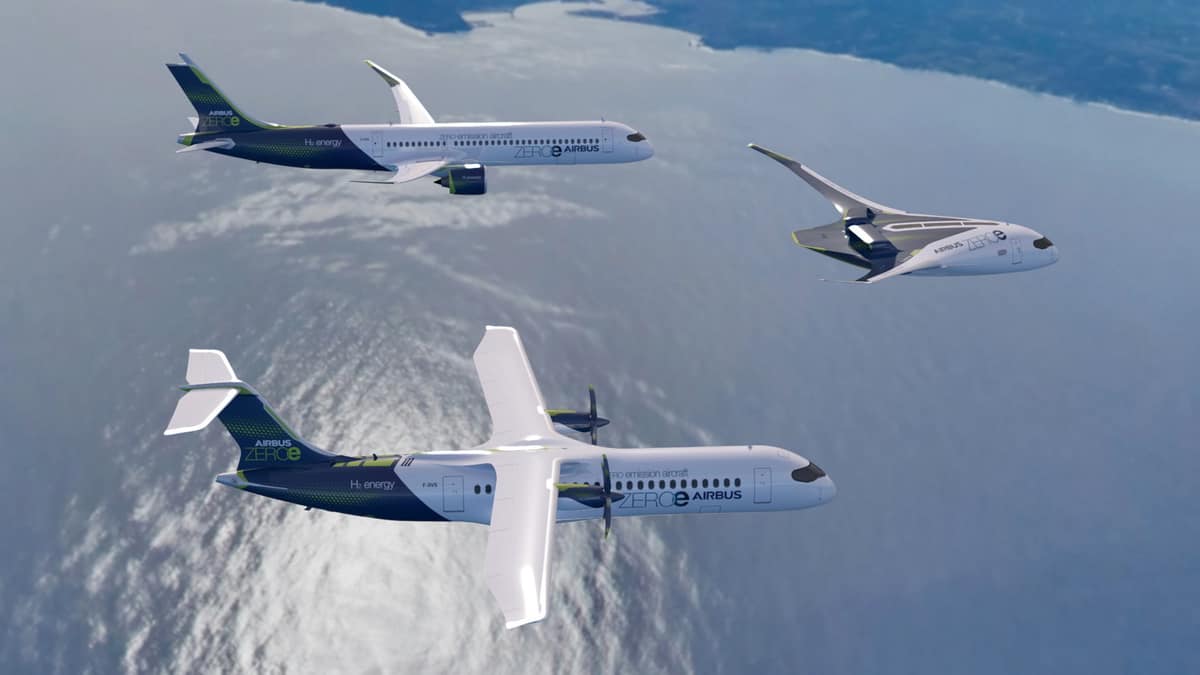Building the world’s first zero-emissions commercial aircraft by 2035 is no easy feat. A future with hydrogen-powered aircraft at the center of aviation would require reliable supplies of hydrogen at airports worldwide, sufficient production of green hydrogen, in-depth safety measures for passengers and collaboration across the aviation industry.
Airbus is seeking to help make that future a reality with its three recently announced ZEROe concept aircraft powered by hydrogen.
It is partnering with ElringKlinger, which will provide the fuel-cell technology and acquire a noncontrolling interest in Airbus. Modified gas turbine engines will burn liquid hydrogen as fuel while hydrogen fuel cells create electrical power that complements the gas turbine, according to Airbus.
Here are some details about the three aircraft concepts:
- Turbofan: You might recognize the turbofan variant because of its conventional looks. This aircraft is designed to fly 2,000-plus nautical miles (NM) while carrying 120-200 passengers. The turbofan has a chimney at the top of its back fin built to release hydrogen gas in the event of a leak. The liquid hydrogen in the turbofan and turboprop concepts would be stored behind the passenger cabin.
- Turboprop: The turboprop is designed to fly fewer than 100 passengers for shorter distances, up to 1,000 NM. Its cruise speed is Mach 0.5, slightly slower than the Mach 0.78 cruising speed of the other two concepts. True to its name, the turboprop concept uses two hydrogen hybrid turboprop engines.
- Blended-wing body (BWB): The BWB concept is designed to fly about 2,000 NM carrying fewer than 200 passengers. Similar to the turbofan, it would use two hydrogen hybrid turbofan engines. The BWB concept allows more space and flexibility for passengers and hydrogen storage because it blends the wings into the body of the plane.
Strict safety measures, increased collaboration and green hydrogen
The space industry has been using hydrogen to power rockets for years. For purposes of the three ZEROe aircraft, the Airbus Defence and Space’s Engineering Division stepped up to lend its expertise for the safe storage of liquid propellants. Hydrogen turns into liquid at minus 425 Fahrenheit (minus 235 Celsius), so Airbus will use cryogenic containers to store the liquid hydrogen in flight, Chief Technology Officer Grazia Vittadini says.
Most hydrogen fuel comes from steam-methane reforming, which results in greenhouse gas emissions, according to the Energy Information Administration (EIA). However, Airbus notes, “green hydrogen” can be created through water electrolysis that extracts hydrogen from water using renewable resources. Less than 0.1% of global hydrogen production is considered green hydrogen, according to Airbus.
Why hydrogen? Why now?
“We’re talking about delivering zero-emission flight to society,” said Glenn Llewellyn, vice president of zero emissions at Airbus.
In a live webcast on Sept. 21 — Zero Emissions Day — Airbus experts shared the details of the three ZEROe concept aircraft and called for the aviation industry to come together to lower aviation emissions worldwide. They recognized the impact of aviation on climate change and stated that a transition to hydrogen in many industries is an important step toward reaching Paris Agreement goals.
Vittadini said hydrogen has much more potential than electric batteries to successfully transition air travel to a lower-emission future. Airbus is not ruling out other zero-emission alternatives but will focus on hydrogen to meet its zero-emission commercial aircraft goal by 2035.
“There is no silver bullet in our industry when it comes to decarbonizing aviation. We need to work concurrently and coherently on multiple pathways,” Vittadini said. Though hydrogen requires four times the volume of kerosene, Vittadini argued that hydrogen has the greatest potential to decarbonize aviation because it can provide the same amount of energy as kerosene for one-third of the weight. The volume required presents a challenge that Airbus engineers have to face while designing these concept aircraft.
Click here for more FreightWaves articles by Alyssa Sporrer.
Related Stories:
Air cargo sector shoots toward 2021 recovery
5 air cargo sustainability trends for 2021
Lufthansa, DB Schenker challenge industry to support alternative jet fuel











